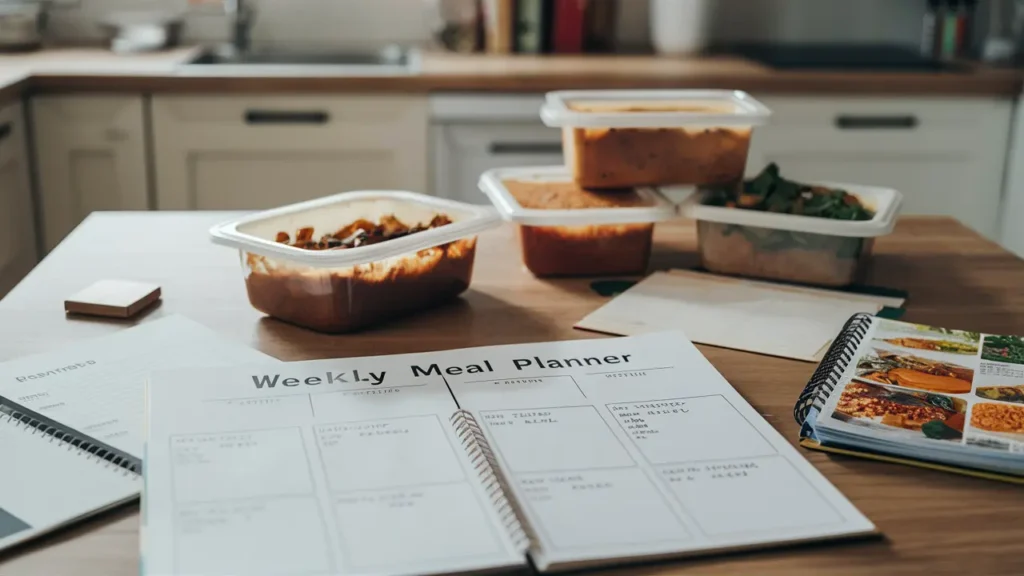Introduction to Family Meal Planning
Ah, the joyous chaos of family life! In the whirlwind of daily routines, family meal planning emerges as a beacon of organization, promising not only to ease your weekly grind but also to enrich your family’s health and wallet. But what exactly does it mean to engage in meal planning? And how can it transform your mealtime from stress to success? Let’s dive into the world of meal planning where saving time, reducing waste, and eating healthily are all on the menu.
What is Family Meal Planning?
Family meal planning is the simple, yet profound, act of mapping out your family’s meals for the week or month. By planning what and when you’ll eat, you can manage grocery shopping more effectively, reduce food waste, and alleviate the daily stress of the dreaded question: “What’s for dinner?”
Definition and Importance
At its core, family meal planning involves selecting recipes, shopping for ingredients according to the plan, and preparing meals ahead of time. It’s like having a road map for your weekly diet; without it, you might find yourself wandering in the wilderness of fast-food menus and last-minute cooking decisions.
Benefits for Busy Families
Oh, the benefits are many! From cutting down on impulsive food purchases (saving you some precious pennies!) to ensuring everyone in the family gets a nutritional meal even on the busiest of days, meal planning is almost too good to be true. It also means less time spent thinking about food, and more time enjoying it together. Imagine that—more family dinners where everyone is laughing and sharing stories over a meal you planned and prepared with ease.
Why Family Meal Planning is a Game-Changer
From reducing grocery bills to improving dietary habits, the advantages of meal planning touch every facet of family life.
Savings on Time and Money
Let’s face it; time is as precious as ever. Family meal planning helps you reclaim some of that lost time. By knowing what you’re going to eat in advance, you can avoid multiple trips to the supermarket each week. And let’s not forget about the money aspect. By buying only what you need, you can dodge those expensive takeout bills and impulse buys that happen when you shop hungry or unprepared.
Health Benefits
With a meal plan, you’re more likely to eat a balanced diet rich in fruits, vegetables, and whole grains since you’re not making last-minute decisions based on cravings or convenience. This planned approach can lead to better overall health for you and your loved ones, turning mealtime into a cornerstone of a hearty life.
Strengthening Family Bonds
By involving the entire family in the meal planning process, you’re not just preparing meals—you’re making memories. Decide on recipes together, shop together, and cook together. It’s a fantastic way to teach kids about nutrition, cooking, and the importance of healthy eating habits.
Part 1 provides a detailed exploration of what family meal planning is and why it should be a pivotal part of your household routine. As we journey further, we’ll discover the essential tools and strategies to make meal planning a breeze and a bliss. Stay tuned as we delve deeper into setting up your family meal planning system in Part 2.
Practical Tips for Successful Meal Planning
Now that you’ve set up a meal planning system, let’s dive into some practical tips to ensure your meal plans are not only sustainable but also successful. These strategies will help you create a meal plan that suits your family’s preferences and lifestyle.
How to Create a Balanced Meal Plan
Creating a balanced meal plan is crucial for ensuring your family gets the necessary nutrients to stay healthy. Here’s how you can make it happen:
Nutritional Guidelines
Start by familiarizing yourself with basic nutritional guidelines. Incorporate a variety of food groups in your meals, including plenty of fruits and vegetables, proteins, and whole grains. Websites like ChooseMyPlate.gov offer fantastic resources for understanding these needs and planning meals that fit into a balanced diet.
Incorporating Variety
Keep things interesting by rotating meals and trying new recipes. This not only prevents mealtime monotony but also ensures a range of nutrients. Think themed dinner nights like “Meatless Monday” or “Fish Friday” to add a fun twist while maintaining nutritional balance.
Budget-Friendly Meal Planning
Let’s be honest, budgeting is crucial, and meal planning can be a significant relief to your wallet if done right.
Tips for Grocery Shopping
Plan your meals around your supermarket’s sales and seasonal produce. This approach not only saves money but also ensures freshness. Always shop with a list to avoid impulse buys that can increase your spending and lead to waste.
Utilizing Leftovers Creatively
See leftovers as an opportunity rather than a burden. Transform last night’s roasted chicken into a savory soup or a hearty salad for lunch the next day. Getting creative with leftovers will help you stretch your food budget and reduce waste.
Part 3 has outlined key strategies to enhance the success of your family meal planning through nutritional balance and budget considerations. Stay tuned for the next section, where we’ll tackle common meal planning challenges and provide solutions to keep your family happy and healthy at the dinner table in Part 4.
Overcoming Common Meal Planning Challenges
Even the best-laid plans can face hurdles. In this part, we delve into common challenges of family meal planning and offer practical solutions to ensure that these hurdles don’t derail your mealtime harmony.
Dealing with Picky Eaters
One of the trickiest aspects of meal planning for families is catering to picky eaters. It can feel like a culinary tightrope walk, but here are a few strategies that can help.

Strategies to Involve Children
Involving kids in the meal planning and preparation process can significantly increase their interest in the food served. Let them pick recipes or help with simple tasks in the kitchen. This not only makes them more likely to eat what they’ve helped prepare but also sparks an interest in varied foods.
Making Meals Fun
Who says dinner can’t be playful? Try serving food in creative ways that appeal to children—think rainbow-colored veggies or sandwiches cut into fun shapes. Introducing a « taste test » game where they rate different dishes can also make dining more engaging and less of a battlefield.
Adjusting Plans for Unexpected Events
Life is unpredictable, and sometimes, even the best plans need to be adjusted. Here’s how to keep your meal plan flexible and stress-free.
Flexibility in Meal Planning
Build some leeway into your meal plans for those days when things don’t go as planned. Have a couple of quick-fix recipes up your sleeve for such occasions—dishes that can be made in under 20 minutes or that use pantry staples.
Quick-fix Meal Ideas
Quick pastas, stir-fries, and wraps are great options for nights when time is short. These meals can be nutritious and satisfying without requiring extensive preparation time or ingredients.
In Part 4, we’ve tackled some common challenges you might encounter in your family meal planning journey and provided strategies to overcome them. Up next in Part 5, we’ll explore advanced meal planning strategies that can help you further optimize your meal preparation and make your food routine even smoother.
Advanced Meal Planning Strategies
As you grow more comfortable with basic meal planning, it’s time to elevate your approach. Advanced strategies can help you further streamline your process, save more time, and enhance the nutritional quality of your meals. Let’s explore how you can apply these techniques to your family meal planning routine.
Seasonal Meal Planning
Eating according to the seasons not only supports local farmers but also provides your family with fresher, tastier, and more nutritious meals. Here’s how to make the most of seasonal meal planning:
Benefits of Seasonal Eating
Seasonal foods are often harvested at their peak of freshness, which means they pack more nutrients and flavor. Moreover, these foods are generally cheaper when they are in season, offering significant savings on your grocery bills.
Finding Seasonal Recipes
To make the most of seasonal eating, find recipes that highlight the natural flavors of the produce. Websites like Epicurious.com are great resources for discovering delicious, seasonal recipes that can inspire your weekly meal plans.
Batch Cooking and Freezing
Batch cooking is a powerful strategy for those looking to save time during the week. By preparing meals in large quantities and storing them properly, you can have home-cooked meals ready in a fraction of the time.
How to Effectively Batch Cook
Choose one or two days a week as your cooking days to prepare large portions of staples like grains, proteins, and vegetables. These can be mixed and matched to create different meals throughout the week, reducing your daily cooking time significantly.
Best Practices for Freezing and Reheating
To make the most of your batch cooking efforts, proper storage is key. Use airtight containers or freezer bags to store your cooked foods. Label everything with the date of cooking to keep track of freshness. When reheating, ensure that meals are thawed properly and heated to the right temperature to maintain safety and taste.
Part 5 has introduced you to advanced meal planning strategies that can make your weekly food preparation even more efficient and enjoyable. Next, in Part 6, we will explore the role of technology in meal planning and how digital tools can further simplify and enhance your meal planning efforts.
Tools and Technology to Enhance Meal Planning
Embracing technology can transform your family meal planning from a chore into a streamlined, interactive experience. Here, we explore how various apps and websites can make meal planning more accessible, efficient, and fun.
Best Apps and Websites for Meal Planning
In the digital age, there’s no shortage of tools designed to simplify every aspect of meal planning. Here are some top apps and websites that can help:
Features of Top Meal Planning Apps
Apps like Paprika and Mealime offer comprehensive solutions for the busy home chef. Features such as recipe storage, automated grocery lists, and nutritional trackers make these apps invaluable. They allow you to access your meal plans on the go, adjust serving sizes automatically, and even import recipes directly from the internet.
How Technology Can Simplify Meal Planning
With these digital tools, you can effortlessly plan your meals, shop for groceries, and even track your family’s dietary needs from your smartphone or tablet. This integration of technology into meal planning not only saves time but also ensures you can stick to your meal plan even when you’re away from home.
In Part 6, we’ve delved into how technology can streamline and enhance your family meal planning. These tools are designed to reduce the stress of planning and cooking, allowing you more time to enjoy with your family. Up next, in Part 7, we will wrap up our series with a summary of the key benefits and a final push to get you started on your meal planning journey.
FAQs on Family Meal Planning
As we wrap up our comprehensive guide to family meal planning, it’s essential to address some frequently asked questions that might still linger. These insights can provide clarity and additional tips to help you succeed in your meal planning endeavors.
How to start meal planning for a family?
Starting meal planning involves a few key steps:
- Assess your family’s dietary needs and preferences. Know what everyone likes and any dietary restrictions.
- Choose a planning style that suits your lifestyle. Whether it’s weekly or monthly, find a rhythm that fits.
- Gather recipes that fit your plan. Use a mix of family favorites and new dishes to keep things interesting.
- Make a shopping list based on your planned meals. Stick to it to avoid impulse buys.
- Prep ahead where possible. This can save time during busy weekdays.
What are some quick meal ideas for busy weeknights?
Quick meals are a savior on busy nights. Here are a few ideas:
- Stir-fries: Fast and versatile, using whatever veggies and proteins you have on hand.
- Wraps and sandwiches: Easy to assemble and always a hit.
- One-pot pasta dishes: Minimal cleanup and ready in under 30 minutes.
How can meal planning reduce food waste?
Meal planning allows you to buy only what you need, reducing the chances of food going unused. Also, planning how to use leftovers can prevent food from being thrown away.
How to cater to different dietary needs in one meal plan?
Try to find base meals that can be customized. For example, prepare a simple protein like chicken, and have different sides or sauces that can be added to meet individual preferences or dietary restrictions.
Can meal planning help in losing weight?
Absolutely! By controlling portions and choosing ingredients carefully, meal planning can be a pivotal tool in a weight management strategy.
What are the best ways to store pre-prepared meals?
The key to storing pre-prepared meals is to keep them in airtight containers and refrigerate or freeze them as soon as they have cooled. Labeling containers with the date and contents can also help manage your meal inventory effectively.
Answering these FAQs provides further insights into how family meal planning can be adapted to fit various needs and lifestyles. This practical approach ensures that mealtime remains a joyous occasion for everyone in the family. Let’s conclude our series in Part 8 with a summary of the benefits and final encouragement for your meal planning journey.
Conclusion: Summarizing the Benefits of Family Meal Planning
As we wrap up our extensive journey through the world of family meal planning, it’s clear that the benefits are as plentiful as they are significant. From saving time and money to improving your family’s health and bringing everyone closer together, meal planning is more than just a weekly chore—it’s a lifestyle choice that offers tremendous rewards.

Recap of Key Points
- Time and Cost Efficiency: Planning your meals reduces last-minute grocery runs and takeout, which saves both time and money.
- Healthier Eating Habits: When you plan, you control the ingredients and the portions, leading to better nutritional outcomes for your family.
- Reduced Stress: Knowing what’s for dinner each day lifts a huge burden off your shoulders, allowing you to enjoy mealtime rather than stress over it.
- Family Bonding: Meal planning is an activity that the whole family can participate in, making it a bonding activity that teaches children valuable life skills.
Encouragement to Start Planning
If you haven’t started meal planning yet, now is the perfect time to begin. Start small, perhaps planning just a few meals a week, and gradually build up as you find what works best for your family. Remember, the goal of meal planning is not perfection but progress. Each small step you take can lead to significant benefits for your family’s well-being and your own peace of mind.
Thank you for following along with our comprehensive guide to family meal planning. Whether you’re a seasoned planner or just starting out, we hope you’ve found valuable insights and practical tips to make your mealtime a delightful, stress-free experience for everyone involved. Here’s to healthier, happier meal times ahead!
